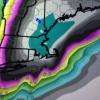-
Posts
74,733 -
Joined
-
Last visited
Content Type
Profiles
Blogs
Forums
American Weather
Media Demo
Store
Gallery
Everything posted by 40/70 Benchmark
-

2024-2025 La Nina
40/70 Benchmark replied to George001's topic in Weather Forecasting and Discussion
Yea, I pinned my December call on the MC forcing that is just being overwhelmed by that potent PNA that is likely at least partially attributable to the ongoing +GLAAM. Hey, after these last couple of years, I would rather be too conservative in terms of east coast cold and snow. -

December 2024 - Best look to an early December pattern in many a year!
40/70 Benchmark replied to FXWX's topic in New England
Yea, they cleaned up on CJ -

2024-2025 La Nina
40/70 Benchmark replied to George001's topic in Weather Forecasting and Discussion
Looks like my main miss so far was the big +PNA Dec...I had it for January, but not December, so I will end up too warm this month. Looks like more of a 2020-2021 Dec-Jan mismatch, as opposed to the Jan 2022 type that I favored. -

2024-2025 La Nina
40/70 Benchmark replied to George001's topic in Weather Forecasting and Discussion
Doesn't really matter. -

December 2024 - Best look to an early December pattern in many a year!
40/70 Benchmark replied to FXWX's topic in New England
I remember the old South Weymouth Naval Air Station used to radiate well. -
Pre-Christmas Winter Storm Possible Next Weekend Holiday Travel Contingencies Should Be Considered Warm ENSO Flavor to Month of December Continues Despite both the Relative Ocean Nino Index (-.80 SON) and the Multivariate ENSO Index (ON) both being indicative of a meager La Niña event, the month of December has featured a notable departure from the type of pattern normally associated with cold ENSO. Although inconsistencies of this nature are much more common in weaker ENSO events, the deviation during this month of December has been much more prominent than one would expect. Here is the prototypical La Niña pattern: Note the prevalent ridge south of the Aleutians, which tele connects to the downstream trough over the west in what is known as the RNA (-PNA) pattern. However, the mean pattern this month has been essentially the opposite, with an Aleutian low that is very redolent of the baseline El Nino pattern. This type of pattern is much more conductive to east coast winter storms during the winter season, and with winter set to begin this weekend, the atmosphere looks as though it just may oblige during the peak of pre-Christmas roadway roadway congestion. High Volume of Holiday Road Traffic Potentially Impacted by Weather The combination of the MJO entering phase 6 and the continuation of a surplus of Angular Atmospheric Momentum will ensure that the aforementioned El Niño like deviation to the pattern will continue throughout the upcoming week and into the weekend. There is now strong cross-ensemble suite support that this will lead to the amplification of a northern stream shortwave courtesy of a deep eastern northeastern trough, at the precise time that pre-holiday roadway congestion is anticipated to peak this weekend. While significant snowfall, or even a storm, is far from a certainty, what is a certainty is that area roadways are going to begin to look a lot more like Christmas this weekend. Thus it is advised that travelers have contingencies in place in the event that the weather follows suite. More to come this week-
-

December 2024 - Best look to an early December pattern in many a year!
40/70 Benchmark replied to FXWX's topic in New England
I woud like a "Who Cares" emoji...need more diversification, as they are kind of redundant. -

December 2024 - Best look to an early December pattern in many a year!
40/70 Benchmark replied to FXWX's topic in New England
12.0









